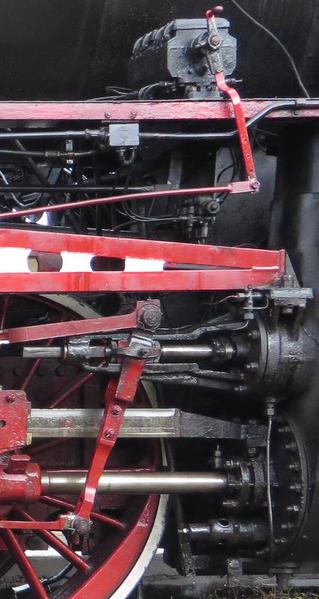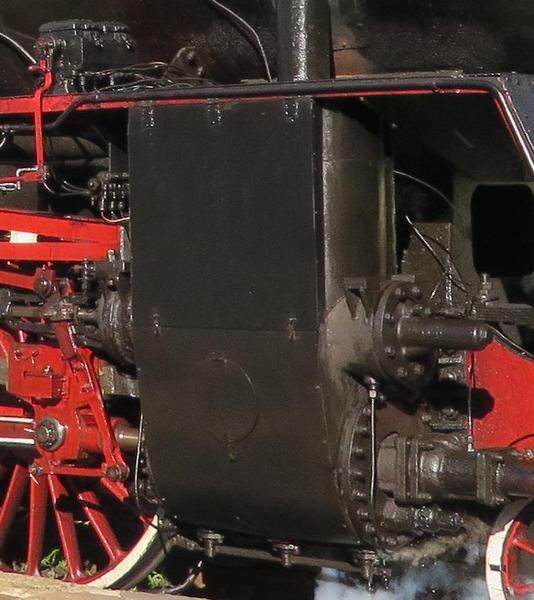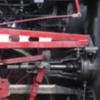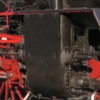This tape has some of the most perfectly groomed high performance steam locomotives crackin the whip on fast passenger trains. Oh, how fortunate are the Brits! Beautiful scenery, great atmosphere, superbly filmed - - take a gander! https://www.youtube.com/watch?v=6mcDsY0TwcA
Replies sorted oldest to newest
The Brits don't hold back. They run them like the used to. Good track!
I've seen the UP 844 making 70_80 mph and it was awesome.
The Brits don't hold back. They run them like the used to. Good track!
I've seen the UP 844 making 70_80 mph and it was awesome.
You are are right about the brit not holding back.I think they had some of their trains runing 125.In the movie fried green tomatoes.There is a sence where 290 roares by pulling freight.It reminded me of my grand parents telling me about the trains they saw.Come to think of it america didn,t hold back ether.
Frankly, just about any steam locomotive at speed is a sight to behold and hear! I have seen the video of 844 hauling buns, and this is a great video, too. And some of those Gresleys could flat out fly.
Thanks for posting the video mark s, I love it!
Beautiful! It is a beautiful sight seeing steam at speed...I remember seeing the 611 at 75-80mph on a couple of occasions...what a sight.
It's funny. I look at steam engines and in some ways, no matter how massive they are, they almost seem "delicate" to me. All of those rods, bearings, and valves reciprocating at outrageous velocities. It's surreal at some level. I've grown up in a generation where all of the moving parts are hidden; cars are the perfect example. Lift the hood on a new car and chances are all you see are battery terminals, some fluid caps, and a huge plastic cover. The stuff that actually makes it 'go' is conveniently obscured from view. Perhaps thats part of my captivation with steam engines - it's all right THERE.
It's funny. I look at steam engines and in some ways, no matter how massive they are, they almost seem "delicate" to me. All of those rods, bearings, and valves reciprocating at outrageous velocities. It's surreal at some level. I've grown up in a generation where all of the moving parts are hidden; cars are the perfect example. Lift the hood on a new car and chances are all you see are battery terminals, some fluid caps, and a huge plastic cover. The stuff that actually makes it 'go' is conveniently obscured from view. Perhaps thats part of my captivation with steam engines - it's all right THERE.
I'd like to see the Acela going that fast.
Those engines, coaches and railroads are spotless and very well maintained. Thanks for sharing.
Excellent video, Mark! Thank you for sharing!
Does anyone know why they sometimes ran with the left headlight on, sometimes the right, sometimes both left and right, and sometimes a center one?
What a cool video! At those speeds, the drivers better be well balanced or it will beat you to death!
Excellent video, Mark! Thank you for sharing!
Does anyone know why they sometimes ran with the left headlight on, sometimes the right, sometimes both left and right, and sometimes a center one?
The location of the light on the front end tells people on the platform what type of train it is. They don't use headlights the way they're used here in the US, as they have very few grade crossings to worry about. Believe it or not, it's common for a Brit engine crew to be humming along and not being able to see anything ahead of them. Don't ask me why that is...
Excellent video, Mark! Thank you for sharing!
Does anyone know why they sometimes ran with the left headlight on, sometimes the right, sometimes both left and right, and sometimes a center one?
The location of the light on the front end tells people on the platform what type of train it is. They don't use headlights the way they're used here in the US, as they have very few grade crossings to worry about. Believe it or not, it's common for a Brit engine crew to be humming along and not being able to see anything ahead of them. Don't ask me why that is...
Lee,
That makes sense. Do you mean tells railroad employees or also passengers on the platform what type train it is? I could see that the general public is probably a lot more informed on railroad practices than they are here.
Thank you very much!
Beats me, I assume mostly for RR employees, but riding trains is FAR more common there and in Europe than it is here. Maybe passengers are savvy enough to be able to read the light placement. Every decent sized town across the pond has a RR depot if its served by a passenger hauling line at all.
It's actually common in Europe to be at a gathering of adults who live in a decent sized town or city and you then discover that none of them own a car and several don't even have drivers licenses. That's why US service people are so popular over there because many of them have cars (and can buy gas at greatly reduced prices, partially subsidized by the US government).
Gotta love the Brits......run them hard and fast.
Funny how I love Brit steam and my Brit friends love my Pony cars!!!
.
It's actually common in Europe to be at a gathering of adults who live in a decent sized town or city and you then discover that none of them own a car and several don't even have drivers licenses. That's why US service people are so popular over there because many of them have cars (and can buy gas at greatly reduced prices, partially subsidized by the US government).
Not sure which books you are reading or films you are watching but that's the biggest load of rubbish I have read in a long time!
.
It's actually common in Europe to be at a gathering of adults who live in a decent sized town or city and you then discover that none of them own a car and several don't even have drivers licenses. That's why US service people are so popular over there because many of them have cars (and can buy gas at greatly reduced prices, partially subsidized by the US government).
Not sure which books you are reading or films you are watching but that's the biggest load of rubbish I have read in a long time!
No books or movies. Saw this myself several times in Europe. In the Netherlands especially, I knew plenty of adults who didn't own cars.
.
It's actually common in Europe to be at a gathering of adults who live in a decent sized town or city and you then discover that none of them own a car and several don't even have drivers licenses. That's why US service people are so popular over there because many of them have cars (and can buy gas at greatly reduced prices, partially subsidized by the US government).
Not sure which books you are reading or films you are watching but that's the biggest load of rubbish I have read in a long time!
No books or movies. Saw this myself several times in Europe. In the Netherlands especially, I knew plenty of adults who didn't own cars.
......and which era are you referring to because I don't remember a time like that and I have been here a good number of years
I think it's a mistake to lump all passenger services together. I lived in Chicago and used the CTA to go everywhere and did not own a car. It was less expensive in consideration of high parking fees both on the street or in a garage let alone the congestion or trying to find a place to park. Light rail is also encouraging this for younger people, particularly students. When the North Shore was running, they would run up to eight jam packed cars with sailors on leave and I am sure the Metra now provides the same services.
Long distance trains versus intercity trains are a different animal. Many intercity trains are recognized for their importance as states pony up to subsidize them.
Long distance trains are in a class by themselves until the USPS gets back on board ( as their experts have advised them) to cross subsidize passenger services. The synergy between two government agencies not being utilised is just stupidity in my book.
I was fortunate to see British steam trains as a teenager when they were still in regular service. What impresses me the most is the maintenance of both the engines and rolling stock. The preservation is first class.
British trains did not have headlights. Most carried marker lamps that told the people in the signal towers which train was passing by the code. Large number boards were displayed during the day for the same purpose on many of the rail lines.
Headlights were not necessary because much of the right of way is fenced. Cows and other critters on the tracks were very rare. You don't see "cow catchers" on British steam locomotives either. The infrastructure was well maintained and you seldom had washouts, falling rocks or other stuff on the tracks. Therefore, a train could run at speed, following the signals with confidence that it wouldn't hit anything.
Grade crossing were manned by men who operated the gates. Automatic crossing gates were just being introduced in the 1950s. The grade crossing gates completely covered the road in both directions. People did not trespass on the tracks.
I was lucky to see all of this during the transition period to diesels. Thanks for sharing the video. It brings back many pleasant memories.
Joe
Bat'le of Britain ...by jove !
Headlights were not necessary because much of the right of way is fenced. Cows and other critters on the tracks were very rare. You don't see "cow catchers" on British steam locomotives either. The infrastructure was well maintained and you seldom had washouts, falling rocks or other stuff on the tracks. Therefore, a train could run at speed, following the signals with confidence that it wouldn't hit anything.
Grade crossing were manned by men who operated the gates. Automatic crossing gates were just being introduced in the 1950s. The grade crossing gates completely covered the road in both directions. People did not trespass on the tracks.
Thanks Joe for your comments.
I still have a hard time seeing myself as engineer running a loco at speed in the dark!!!
I used to play a little trick on visiting friends. If we were out after dark there was a section of road I had driven so many time I could do it in the dark.....and I did.
Friends would actually scream when I cut the lights at 45 mph and drive for a mile or so.
Way out in the middle of nowhere it was DARK. Can't imagine running a speeding loco the same way....gotta hand it to our Brits!!!
Some of the locomotives pictured in the tape are Merchant Navy Class......very handsome machines and seemingly quite modern in apurtanances. At the time of their construction, a larger high speed passenger locomotive was needed for the Southern Ry, so a 4-8-2 was proposed. But, the civil engineers on the railroad objected re the higher axle weight, so they went to the smaller 4-6-2 locomotive. Which somewhat tells the story of British steam......small locomotives, but highly refined. The Merchant Navy class when built, had a full streamlined jacket (later removed) and were nicknamed "Spam Cans"!
In 1960 my Uncle had visited England and he picked up a "train spotters" hip pocket locomotive guide for me. Of course, at that time much of British Rail was steam operated (they built their last new steam locomotive in March 1960). I was quite surprised to see locomotives as old as 1860's construction dates, still in operation. Additionally was surprised to see that BR had stabled two Beyer-Garretts, for "banking" (pushers on grades, not to take cash deposits!). Have always had an affectionate spot for British steam.
I still have a hard time seeing myself as engineer running a loco at speed in the dark!!!
I used to play a little trick on visiting friends. If we were out after dark there was a section of road I had driven so many time I could do it in the dark.....and I did.
Friends would actually scream when I cut the lights at 45 mph and drive for a mile or so.
Way out in the middle of nowhere it was DARK. Can't imagine running a speeding loco the same way....gotta hand it to our Brits!!!
One night our train was headed around a curve to the left and there was a road just off to my right and below the roadbed. Some smarty in a car speeded up to the side and was pacing us around the curve. The headlights on the unit was illuminating the road pretty good, so, the driver in the car turned his headlights off and was negotiating the curve by the light from our unit. That's when I turned my headlights off and left him in the dark.
Here is a nice one from the footplate of the Duke of Gloucester.
Here is a nice one from the footboard of the Duke of Gloucester.
The correct term is "footplate", which means "cab ride" to we colonists.
This is an extremely well done video, and a few interesting points I noticed:
1) The British steam locomotives have steam powered brake system for the locomotive (independent brake for us), while the train braking system is vacuum.
2) I found it interesting that the Fireman periodically puts a blocking device in the fire doors, or leaves the fire doors completely open at times. Must be for smoke abatement?
3) Notice how smoothly the cab signal/train contra system worked.
3) Notice that the Driver (Engineer) initially applied the train brakes, in order to slow to 75!!!!! Although he never stated what his top speed was, I'll bet it was close to 90.
4) Don't you just love the exhaust sounds of those British 3-Cylinder 4-6-2 locomotives?
Forgot to add:
5) Nobody is wearing safety glasses/googles!
6) Nobody is wearing those stupid looking high-visability "safety vests/jackets".
EXCELLENT video, and thanks for posting THAT ONE!
Chaps,
First video - The Head Code, the lights on the loco front, told men in the multitude of signal boxes the type of train and route. Vital as the number of trains was immense.
Second video - Thank goodness I was smart enough to be a Life Member of the Duke of Gloucester Society and a share owner of the Bluebell Railway Society.
http://www.bluebell-railway.com/
ChipR
quote:The correct term is "footplate", which means "cab ride" to we colonists.
Yeah, I realized what I had written later that day and forgot to go back and change it. I knew someone would catch it.
quote:2) I found it interesting that the Fireman periodically puts a blocking device in the fire doors, or leaves the fire doors completely open at times. Must be for smoke abatement?
And how the Driver locks the reverser.
I'm glad I didn't have to switch with a reverser like that!
quote:2) I found it interesting that the Fireman periodically puts a blocking device in the fire doors, or leaves the fire doors completely open at times. Must be for smoke abatement?
And how the Driver locks the reverser.
I'm glad I didn't have to switch with a reverser like that!
Something else I forgot to mention:
Did anyone notice that the Driver (Engineer) closed the regulator (throttle) COMPLETELY when it was time to slow down, plus he "added a little blower"? Are those British 3-Cylinder steam locomotives THAT different that the Driver can simply close the regulator without drawing a vacuum in the smokebox? Also, how do the cylinders get lubrication with the regulator closed? They must not do "power braking" either on their passenger trains.
Still a FANTASTIC video!
quote:2) I found it interesting that the Fireman periodically puts a blocking device in the fire doors, or leaves the fire doors completely open at times. Must be for smoke abatement?
And how the Driver locks the reverser.
I'm glad I didn't have to switch with a reverser like that!
Something else I forgot to mention:
Did anyone notice that the Driver (Engineer) closed the regulator (throttle) COMPLETELY when it was time to slow down, plus he "added a little blower"? Are those British 3-Cylinder steam locomotives THAT different that the Driver can simply close the regulator without drawing a vacuum in the smokebox? Also, how do the cylinders get lubrication with the regulator closed? They must not do "power braking" either on their passenger trains.
Still a FANTASTIC video!
I did notice that but didn't think anything of it at first, until you mentioned it. The folks in Wolsztyn, Poland do the same with their steam, sometimes coasting for what seemed like a couple of miles into a station stop. Thanks to the language barrier I never could inquire as to why this was possible, but I had to guess it was one of the many lines coming off the lubricator running to the steam chest area. Trying to dig up a picture, maybe you can shed some light on it...
---EDIT---
Found these pics from my trip. Is it just me, or do they have the mechanical lubricator piped to the bushings on the valve gear? Would that be enough lubrication, or even the right type, for this to make sense?








